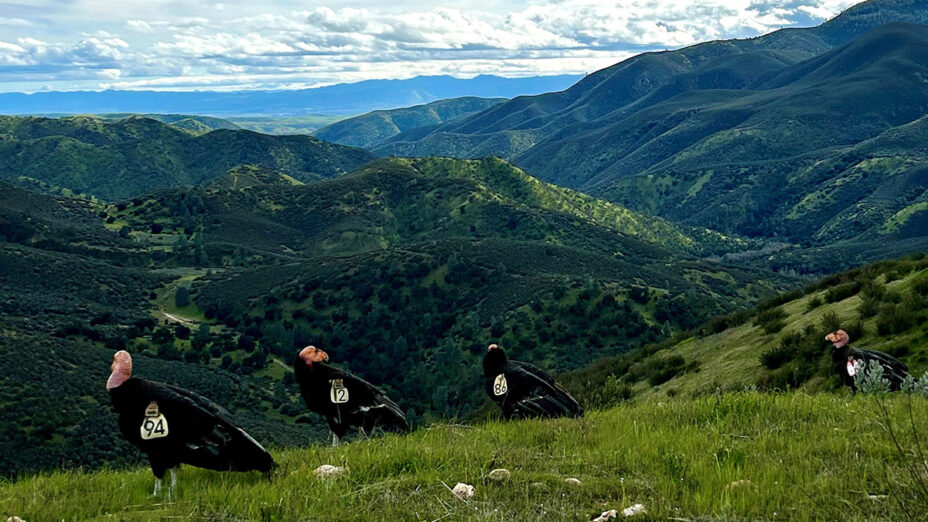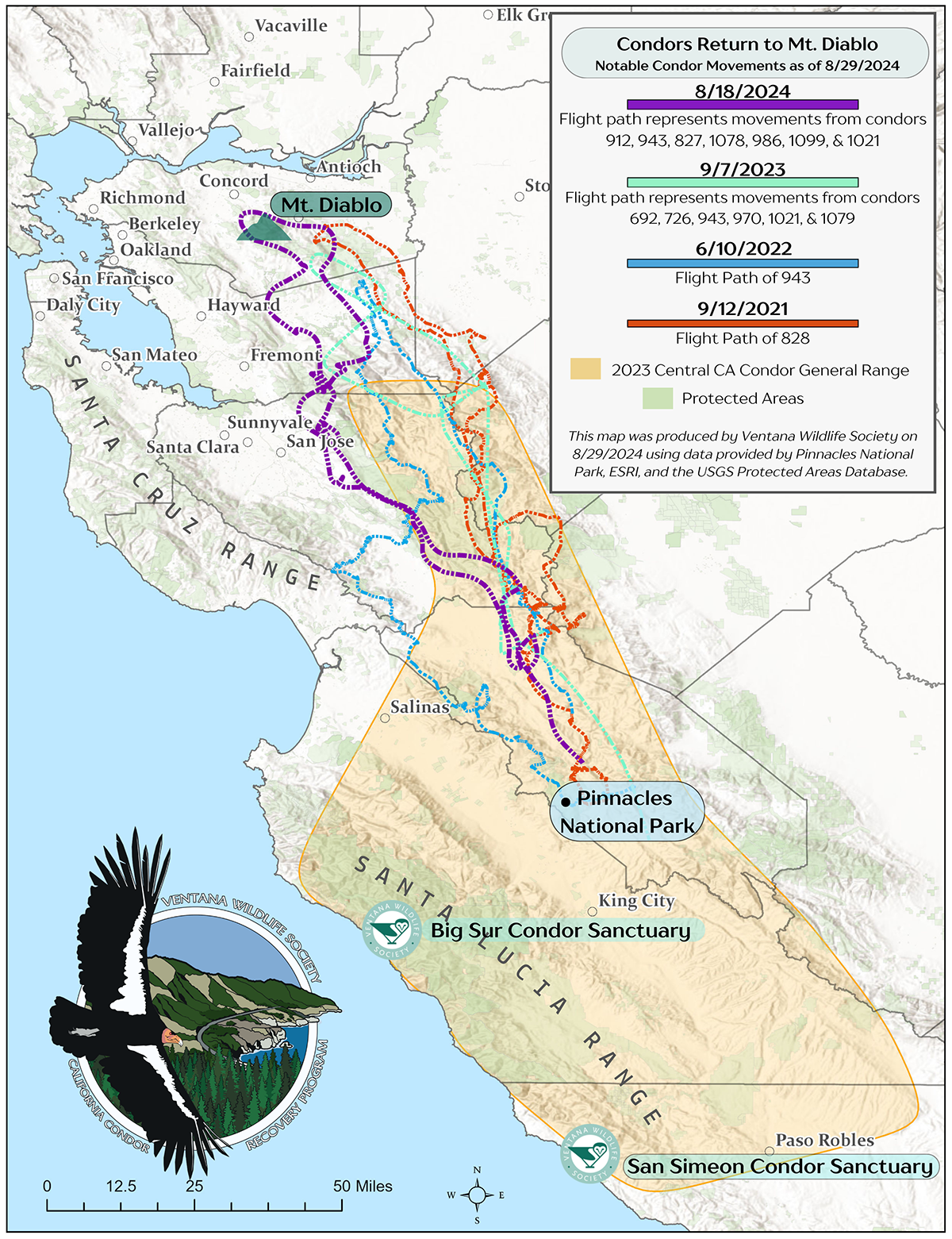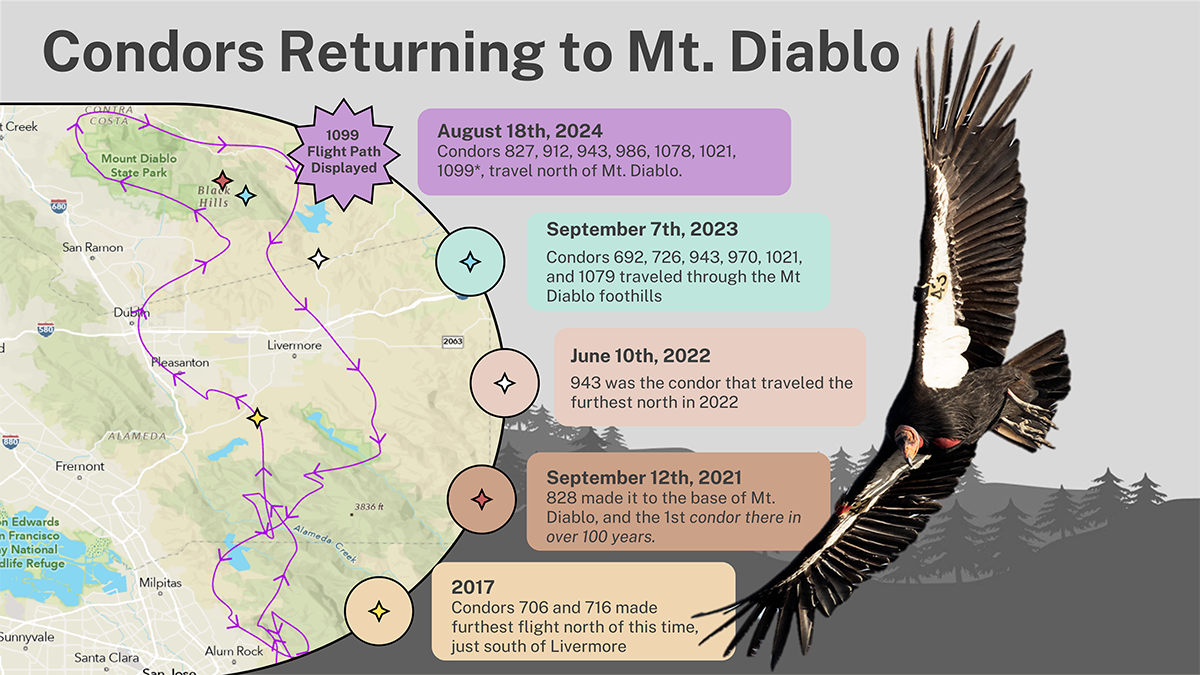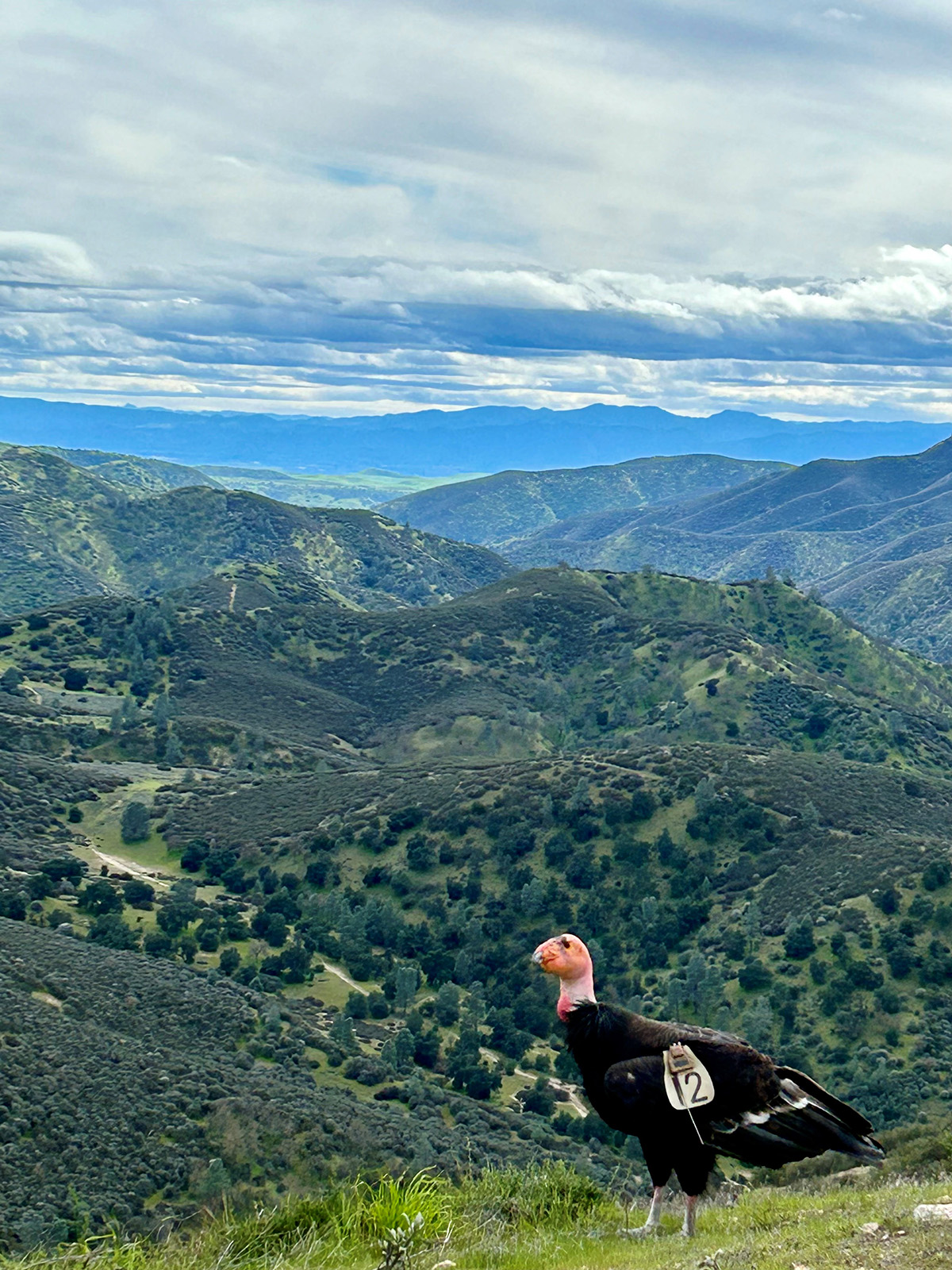
WALNUT CREEK, CA—On August 18, 2024, seven California condors flew north into Alameda and Contra Costa counties on a circuitous aerial tour.
The three-hour flight began shortly after noon, when they left their previous evening’s roost site south of Ohlone Regional Wilderness.
They soared over Pleasanton and Sunol, near the intersection of Highways 580 and 680 and the furthest west the birds have flown in the East Bay. They flew over Dublin and Tassajara.
They ventured north over Mount Diablo’s Pine Canyon near Castle Rock—a possible future nesting site and where Save Mount Diablo previously helped reestablish endangered peregrine falcons—and as far north as Lime Ridge Open Space west of Clayton before veering east—the furthest north the birds have flown in Contra Costa County.

Map showing notable condor movements from Pinnacles National Park to the Mount Diablo region. Map: Evan McWreath/Ventana Wildlife Society
They circled Mount Diablo before heading south over the outskirts of Livermore and then spending the night in the mountains near Lake Del Valle. The condors, fitted with radio and GPS transmitters, did not appear to have landed during their time in the area.
We know all of this because wildlife biologist Joseph Belli, who volunteers for the California condor recovery program at Pinnacles National Park, also works closely with Save Mount Diablo and pays special attention to birds ranging up and down the Diablo Range.
The condors’ flight paths, tracked via GPS, highlight the vital role the Diablo Range plays as a wildlife corridor.
Save Mount Diablo, which recently expanded its geographic scope to 12 counties, has been instrumental in supporting these efforts, funding GPS transmitters and data subscriptions that allow for detailed tracking of the condors’ movements.
“I’ve been monitoring condors for nearly 20 years and it’s wonderful to see groups of them exploring further north in the Diablo Range every summer for the past four years.
“We would rarely know of these long-range flights if it weren’t for the GPS transmitters on some of the condors. I wouldn’t be surprised if these summer forays continue into the future, so all you eagle-eyed condor enthusiasts should keep an eye to the sky!” said Alacia Welch, the Condor Program Manager at Pinnacles National Park.
“I was riding my mountain bike at Lime Ridge, and I noticed a group of rather large birds a couple times but kept on riding, not looking too much into it because why would I think they could be condors,” said Frenchy Hendryx, a former Save Mount Diablo employee.
“The next day I heard the story that condors had flown over the area from Sean [Burke], and at that point, I wanted to know what time they had flown over. When the times matched, I got excited. I may have seen condors!
“I will definitely be looking out for them now and paying closer attention. A condo of condors is just not something you see every day in the Mount Diablo area.”

Condors returning to Mount Diablo. Graphic: Evan McWreath/Ventana Wildlife Society
If this story sounds familiar, it’s because a very similar event occurred around this time last year, when six condors undertook an exploratory flight near Mount Diablo. It was the first flock in Contra Costa County in 100 years.
Two of them—#1021, a three-year-old male, and #943, a six-year-old male—were also among this year’s group.
#943 made news in June 2022 for making a solo flight near Brushy Peak, the second condor documented in the area in over a century after #828’s ground-breaking journey in August 2021.
The other five—#1099, #827, #912, #986, and #1078—are a mixture of juveniles and young adults, both male (#827, #912, #986) and female (#1099, #1078). It’s this age group that tends to undertake ambitious discovery flights.
Older condors with nesting territories tend not to wander as extensively. Condors can begin breeding as early as five years old but generally wait until they’re at least six and often much older before nesting.
#827 is the oldest of the group, an eight-year-old male who has yet to find a mate.
The group is also a blend of condors raised in captivity (#1099, #827, #986, #943) and products of wild nests (#1021 in southern San Benito County, #1078 and #912 in Pinnacles National Park).
Pinnacles and Ventana Wildlife Society co-manage the flock, managing release sites and monitoring the birds from the park and Big Sur.
All condors have radio transmitters because there are so few, and each one is important to the overall population. That allows the birds to be tracked if necessary.
Some also wear GPS transmitters (less than half the flock have GPS, though most Pinnacles birds do, thanks in part to Save Mount Diablo).
In the last few years, Save Mount Diablo has funded additional GPS transmitters and subscription services for Pinnacles birds with grants from its Mary Bowerman Science and Research Program.
The transmitters and subscription services allow precise flight tracks to be monitored and recorded.
Condors prefer to fly over undeveloped areas.
The theory in making the grants for GPS transmitters and subscriptions, especially for young birds, was that their GPS flight tracks would define and highlight the importance of the giant Diablo Range as habitat for the birds—200 miles north-south and 3.5 million acres of high-quality intact habitat.
The theory is proving to be true.
The central California flock consists of roughly 100 free-flying condors, ranging from north of Paso Robles and San Luis Obispo to southern Santa Clara County and occasionally beyond.
That number will increase toward the end of the year, when 10 to 12 young condors raised in captivity will be released.
It’s also been a banner year for nesting, with a record nine chicks potentially ready to fledge in fall. The growing population bodes well for the future and the likelihood of more frequent condor appearances in the East Bay.
Special thanks to Joseph Belli, a wildlife biologist working closely with our organization, for his work in tracking California condors.
Belli’s new book, Beneath a Black and White Sky: A Year Among Condors at Pinnacles National Park, offers a deeply personal look at the condor recovery program and the challenges and triumphs of conserving these incredible birds.

Wildlife biologist Joseph Belli recently published a new book about California condors, Beneath a Black and White Sky: A Year Among Condors at Pinnacles National Park. Illustration: Megan Gnekow
His work underscores the critical importance of habitats found in the Diablo Range for the future of the condor population.
As Save Mount Diablo continues to expand its efforts across the Diablo Range, its focus remains on ensuring that wildlife connectivity persists for future generations. The protection of these lands is crucial to the survival of California’s most iconic species.

Condor #912, one of the California condors that flew to the Mount Diablo region on August 18, 2024. Photo: Joseph Belli
About Save Mount Diablo
Save Mount Diablo is a nationally accredited, nonprofit land trust founded in 1971 with a mission to preserve Mount Diablo’s peaks, surrounding foothills, and watersheds; and its sustaining Diablo Range, through land acquisition and preservation strategies designed to protect the mountain’s natural beauty, biological diversity, and historic and agricultural heritage; enhance our area’s quality of life; and provide educational and recreational opportunities consistent with protection of natural resources. To learn more, please visit www.savemountdiablo.org.
Image Captions and Credits
- Condor flock at Pinnacles National Park. Two of the birds in this picture, the ones in the middle with numbers 12 and 86 on their tags, were among those who flew to the Mount Diablo foothills on August 18, 2024. Photo: Joseph Belli
- Map showing notable condor movements from Pinnacles National Park to the Mount Diablo region. Map: Evan McWreath/Ventana Wildlife Society
- Condors returning to Mount Diablo. Graphic: Evan McWreath/Ventana Wildlife Society
- Wildlife biologist Joseph Belli recently published a new book about California condors, Beneath a Black and White Sky: A Year Among Condors at Pinnacles National Park. Illustration: Megan Gnekow
- Condor #912, one of the California condors that flew to the Mount Diablo region on August 18, 2024. Photo: Joseph Belli
Higher resolution versions of these images are available upon request; please contact lkindsvater@savemountdiablo.org.
MEDIA CONTACT:
Laura Kindsvater, Senior Communications Manager
C: 925-451-8376, lkindsvater@savemountdiablo.org
Seth Adams, Joseph Belli, and Alexander Broom contributed to this press release.
###

